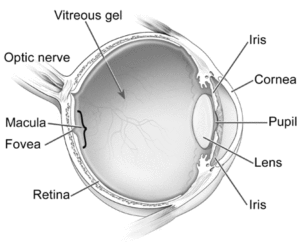Blog
Healthy Eyes


How do the parts of your eyes work together so you can see?
The different parts of your eyes collaborate to create vision. They include:
- Cornea. This clear, dome-shaped surface covering the front of your eye bends (refracts) light coming into your eye.
- Iris. This colored part of your eye regulates the size of your pupil, which opens and closes to control the amount of light coming into the eye.
- Lens. This clear disk inside your eye focuses light onto your retina.
- Retina. Light-sensing tissue in your eye contains “photoreceptor cells” that convert light into electrical signals.
- Optic nerve. The electrical signals from your retina are transmitted through the optic nerve to your brain, which processes them into the images you see.
What can I do to keep my eyes healthy?
Any injuries, disorders, or diseases that impair the delicate interplay between the parts of your eyes can adversely affect your vision—sometimes permanently. So it’s important to take steps like these to take care of your eyes:
- Get a comprehensive dilated eye exam regularly. Your eye care professional can assess your vision and examine deep inside your eyes to check for any disorders. This is especially important as you age, when you are at increased risk of age-related macular degeneration, cataracts, and glaucoma—some of which may not cause symptoms.
- Take care of your overall health. Many eye diseases are related to other health issues, such as diabetic retinopathy in people with uncontrolled diabetes and glaucoma in people with high blood pressure. Follow your doctor’s advice and take any medications as prescribed to control blood sugar and blood pressure and to maintain a healthy weight. Doing so will minimize your risk of eye disease.
- Eat a healthy diet. A diet rich in fruits and vegetables, including dark leafy greens, as well as fatty fish like salmon, tuna, and halibut is good for your eyes.
- Protect your eyes from injury and damage. Wear safety glasses, goggles, and safety shields during certain sports (like baseball and racquet sports), while working with power tools, and if they are needed in your workplace. Wear sunglasses that block ultraviolet radiation.
- Don’t smoke, and if you do, quit. Smoking raises your risk of many eye diseases, such as age-related macular degeneration, cataracts, and optic nerve damage.
- Take periodic eye breaks. Staring at a computer all day, or any object, can make you blink less and cause eye fatigue. Follow the 20-20-20 rule: look away for 20 seconds every 20 minutes at something 20 feet in front of you, which can reduce eyestrain.
- Clean your hands and contact lenses properly. Wash your hands before handling contact lenses, and be sure to disinfect and store the lenses as instructed. Also wash your contact lens case before putting in new solution.
- Know your family’s eye health history. Many types of eye diseases are inherited. Knowing which ones may run in your family and sharing this information with your doctor can help determine if you have an increased risk of eye disease.
Source: The National Eye Institute (NEI)